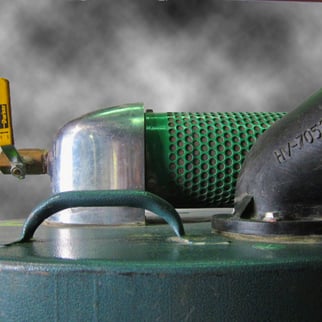 With the recent update to NFPA 654 requiring a Dust Hazard Analysis, many facilities are going to be cleaning up dust issues that they haven’t dealt with in the past, and many are going to be finding out that their dust accumulations are actually combustible. This discovery means that ordinary cleaning methods and equipment are not allowed to be used, and specially designed explosion proof vacuum cleaners must be used by trained dust remediators.
With the recent update to NFPA 654 requiring a Dust Hazard Analysis, many facilities are going to be cleaning up dust issues that they haven’t dealt with in the past, and many are going to be finding out that their dust accumulations are actually combustible. This discovery means that ordinary cleaning methods and equipment are not allowed to be used, and specially designed explosion proof vacuum cleaners must be used by trained dust remediators.
So what’s the difference between a regular vacuum and an explosion proof vacuum, a why does it matter?
The biggest difference is with the basic design and operation of the vacuums. Normal vacuums use a motor to create suction, but explosion proof vacuums have no motor or moving parts, and instead rely on compressed air to create suction. This prevents any sort of spark from the motor or friction, or heat from the motor and moving parts from being able to ignite an explosion.
It also means that the vacuum doesn’t directly use any electricity, so there are no electrical wires or electrical sparks to worry about causing issues in a hazardous situation. In normal vacuums that are powered by electricity there are plugs and switches or arcing motors that can cause sparking hazards, or if the wire becomes damaged it can create sparks and heat that ignite the dust.
The movement of dusts through hoses creates static electricity, which can build up to be enough to create a spark strong enough to ignite a combustible dust cloud. An explosion proof vacuum has all of its parts bonded together and then grounded, in order to discharge any built up static safely, preventing any sparks or explosion hazards.
Finally, the explosion proof vacuums are mounted on a metal drum that collects the dust, and when full the drums are sealed off and disposed of, keeping the dust contained and safe from any future explosion risks. Combustible dust is considered a hazardous material and must be handled like one when collected, and metal drums are an approved method of containment. Regular vacuums are typically bags or a plastic container, which then needs to be emptied into another area for disposal, creating a combustible dust hazard in a new area.
Need help getting your facility up to the new combustible dust regulations? Contact us now to find out how we can help.
888-845-3952 or Contact Us

